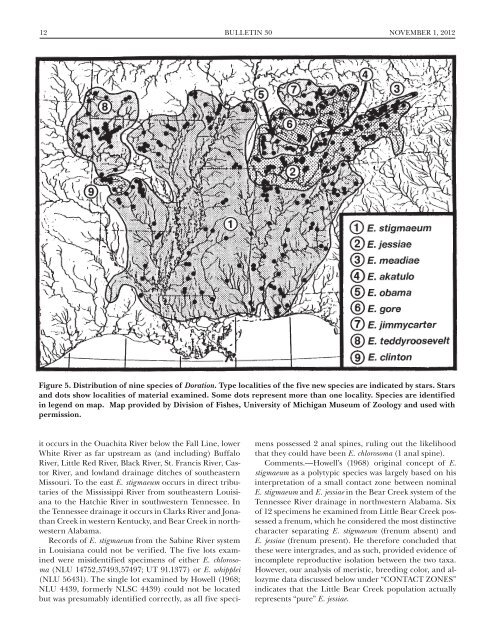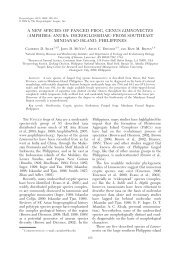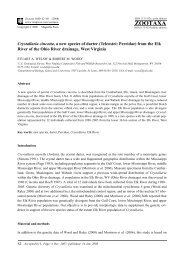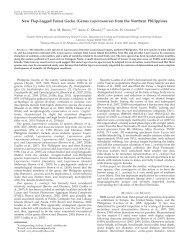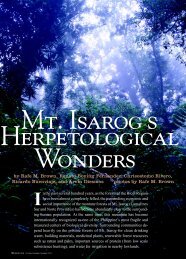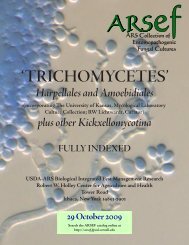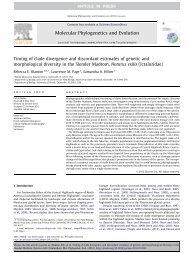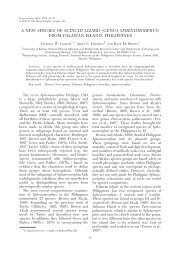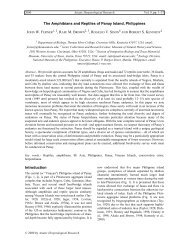12 Bulletin 30 NOVEMBER 1, 2012Figure 5. Distribution <strong>of</strong> nine species <strong>of</strong> Doration. Type localities <strong>of</strong> the five new species are indicated by stars. Starsand dots show localities <strong>of</strong> material examined. Some dots represent more than one locality. <strong>Species</strong> are identifiedin legend on map. Map provided by Division <strong>of</strong> Fishes, University <strong>of</strong> Michigan Museum <strong>of</strong> Zoology and used <strong>with</strong>permission.it occurs in the Ouachita River below the Fall Line, lowerWhite River as far upstream as (and including) BuffaloRiver, Little Red River, Black River, St. Francis River, CastorRiver, and lowland drainage ditches <strong>of</strong> southeasternMissouri. To the east E. stigmaeum occurs in direct tributaries<strong>of</strong> the Mississippi River from southeastern Louisianato the Hatchie River in southwestern Tennessee. Inthe Tennessee drainage it occurs in Clarks River and JonathanCreek in western Kentucky, and Bear Creek in northwesternAlabama.Records <strong>of</strong> E. stigmaeum from the Sabine River systemin Louisiana could not be verified. The five lots examinedwere misidentified specimens <strong>of</strong> either E. chlorosoma(NLU 14752,57493,57497; UT 91.1377) or E. whipplei(NLU 56431). The single lot examined by Howell (1968;NLU 4439, formerly NLSC 4439) could not be locatedbut was presumably identified correctly, as all five specimenspossessed 2 anal spines, ruling out the likelihoodthat they could have been E. chlorosoma (1 anal spine).Comments.—Howell’s (1968) original concept <strong>of</strong> E.stigmaeum as a polytypic species was largely based on hisinterpretation <strong>of</strong> a small contact zone between nominalE. stigmaeum and E. jessiae in the Bear Creek system <strong>of</strong> theTennessee River drainage in northwestern Alabama. Six<strong>of</strong> 12 specimens he examined from Little Bear Creek possesseda frenum, which he considered the most distinctivecharacter separating E. stigmaeum (frenum absent) andE. jessiae (frenum present). He therefore concluded thatthese were intergrades, and as such, provided evidence <strong>of</strong>incomplete reproductive isolation between the two taxa.However, our analysis <strong>of</strong> meristic, breeding color, and allozymedata discussed below under “CONTACT ZONES”indicates that the Little Bear Creek population actuallyrepresents “pure” E. jessiae.
Layman & Mayden Morphological Diversity and Phylogenetics <strong>of</strong> the Darter subgenus Doration (<strong>Percidae</strong>: <strong>Etheostoma</strong>) 13<strong>Etheostoma</strong> jessiae (Jordan and Brayton)Blueside DarterFigs. 3, 6Poecilichthys jessiae Jordan and Brayton in Jordan, 1878:227,and in Jordan and Brayton, 1878:59 (description fromChickamauga River at Ringgold, Georgia); Jordan,1880:227 (description; distributed in Tennessee River);Jordan and Gilbert, 1883:518–519 (description; knownfrom Chickamauga River, Georgia); Jordan, 1884:227 (description;distributed in Tennessee River; Kuhne, 1939:92(known from Tennessee); Fowler, 1945:39, 251 (distributedin Alabama, Tennessee, and Sabine rivers, based inpart on misidentifications ).<strong>Etheostoma</strong> (<strong>Etheostoma</strong>) saxatile: Gilbert, 1888:57–58 (description;distribution includes tributaries <strong>of</strong> Clinch Rivernear Clinton, Tennessee).<strong>Etheostoma</strong> jessiae: Jordan, 1890: 133 (description; distributedfrom Tennessee to Wabash Valley, Illinois and eastTexas, based in part on misidentifications); Jordan and Evermann,1896:1084 (description; distributed from Indianato Iowa and south to Mississippi and Texas, based largelyon confusion <strong>with</strong> E. asprigene and E. swaini); Evermann,1918:317, 319, 359, 364, 368 (identification <strong>of</strong> species reportedas P. jessiae by Jordan and Brayton (1878) fromChickamauga River at Ringgold, Georgia); Cole, 1967:28–29 (removed from subgenus Boleosoma and placed in subgenusDoration); Howell, 1980a:656 (systematics, distribution,habitat, biology); Page, 1983:26, 80, 238, plates 18Gand 18H (description; range; natural history; key; photos<strong>of</strong> breeding male and female from Little Pigeon River, SevierCounty, Tennessee); Kuehne and Barbour, 1983:16,100, plate 13 (description; distribution; natural history;photo <strong>of</strong> breeding male from West Branch Shoal Cr., LawrenceCounty, Tennessee (Gilbert and Walsh, 1991)).<strong>Etheostoma</strong> stigmaeum: Gilbert, 1891:150, 152 (TennesseeRiver drainage included in range; recorded from CypressCreek, Florence, and Big Nance Creek, Courtland, Alabama).Ulocentra stigmaea: Evermann and Hildebrand, 1916:449–450 (recorded from Ball Creek, tributary <strong>of</strong> Big SycamoreCreek near Tazewell, Tennessee, and Arnwine SpringCreek near Athens, Tennessee; compared <strong>with</strong> specimensfrom Wolf and Obeys rivers; two forms represented); Evermann,1918:320, 321, 326, 356, 367 (identification <strong>of</strong> speciesrecorded as E. (<strong>Etheostoma</strong>) saxatile by Gilbert (1888)from tributaries <strong>of</strong> Clinch River near Clinton, Tennessee;identification <strong>of</strong> species recorded as E. stigmaeum by Gilbert(1891) from Cypress and Big Nance creeks, Alabama;identification <strong>of</strong> species recorded as E. saxatile by Gilbertand Swain, 1884, unpublished, from Bull Run at Hershells,Tennessee, and Clinch River at Clinton, Tennessee).Oligocephalus jessiae: Jordan et al., 1930:291 (distributedfrom southern Illinois to Georgia and Mississippi, basedin part on misidentifications).<strong>Etheostoma</strong> (Boleosoma) jessiae: Bailey and Gosline, 1955:15, 38 (vertebral counts); Collette, 1965:570, 583, 585–586, 608 (description <strong>of</strong> breeding tubercles; systematics);Collette and Knapp, 1966:63, figure 4 (location <strong>of</strong> typematerial <strong>of</strong> nominal species Poecilichthys jessiae unknown;figure <strong>of</strong> possible syntype).<strong>Etheostoma</strong> stigmaeum jessiae: Burkhead and Jenkins,1991:385–387 (description; Virginia distribution and status;habitat; life history; recommendations); Etnier andStarnes, 1994:533–537 (biology; distribution and status;systematics; key; photo <strong>of</strong> female from Little River, Tennessee);Jenkins and Burkhead, 1994:838–840 (systematics;description; biology; habitat; distribution).Syntypes.—Number and dispostion unknown, ChickamaugaRiver at Ringgold, Georgia, summer 1877, D. S.Jordan and A. W. Brayton, assisted by C. H. Gilbert anda party <strong>of</strong> students from Butler University (Jordan andBrayton, 1878). Jordan and Brayton (1878) described thespecies from “Several specimens, each about two incheslong, .... “ Collette and Knapp (1966:63, fig. 4) failed tolocate any type material but found a drawing by ErnestCopeland in the files <strong>of</strong> the USNM Division <strong>of</strong> Fishes labeled“Poecilichthys jessiae, Chickamauga River, Ga,” Theyreproduced the drawing, believing that it probably representsone <strong>of</strong> the lost syntypes.Two papers describing this species were published inthe same year, but that <strong>of</strong> Jordan (1878) apparently preceded,or was intended to precede, by date that <strong>of</strong> Jordanand Brayton (1878). The latter paper references the formerand indicates species authorship as Jordan and Brayton,rather than providing the notation “sp. nov.” Robins et al.(1991:89) cited Jordan (1878) as the original description,pointing to an error in Jordan and Evermann (1896:1085),which gives the publication date for the species as 1877.The paper by Jordan and Brayton (1878) provides a moredetailed description and includes provenance <strong>of</strong> the typespecimens, information lacking in Jordan (1878). In fact,Jordan and Evermann (1896:1085) duplicate the accountfrom Jordan and Brayton (1878) as the “original description<strong>of</strong> Poecilichthys jessiae.” We have been unable to determinewhich <strong>of</strong> the 1878 papers was actually published firstthat year.Diagnosis.—A member <strong>of</strong> the subgenus Doration.Breeding male distinguished by: spinous dorsal fin <strong>with</strong>blue marginal and submedial bands, orange medialband, basal band <strong>with</strong> bright orange pigment; s<strong>of</strong>t dorsal,caudal, and pectoral fins <strong>with</strong> bright orange spots onrays; s<strong>of</strong>t dorsal and anal fins <strong>with</strong> blue in base <strong>of</strong> fin; faceand lower head gray <strong>with</strong> blue on operculum, preoperculum,suborbital bar, and lips (but not mid-gular region);vertically elongate lateral blue bars; basicaudal blue bar


